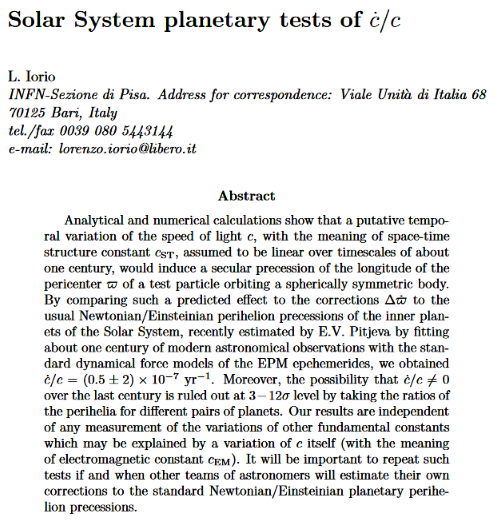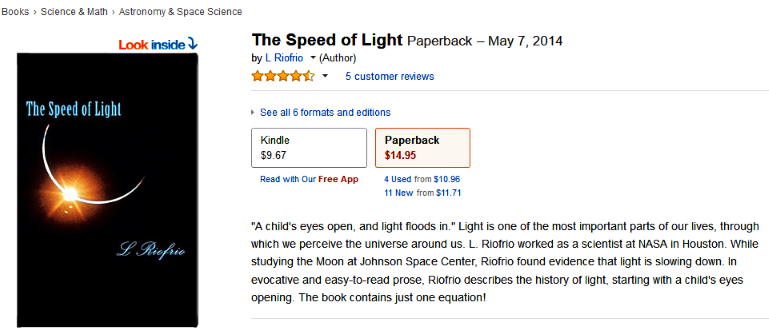Top Customer Reviews:
Louise Riofrio's "The Speed of Light" is a delightfully written, straightforward, clear introduction to the likely role of a slowly declining speed of light in the history of the universe and beyond. It is a quick read that goes easy on the math, maintaining congruence with the theory that formulas describing these events are probably, when mature, quite simple. Even more delightful for me was the opportunity to read the book immediately after Riofrio had presented her work at the monthly meeting of the NASA Johnson Space Center Astronomy club monthly meeting! A double-barreled treat! I suggest you don't pass up a chance to enjoy both as they are very enlightening and entertaining.
The best book on the subject out there. The author examines the concept that the speed of light decreases as the universe expands. This would account for the present state of the universe without resorting to theories of inflation or fudge factors like "dark energy." She gives a history of how the present mainstream thought (that the speed of light is constant) developed, then presents the evidence for VSL in clear prose, refraining from jargon, and she doesn't load the book with equations. A nice addition to any science bookshelf.
From the first sentence in the book, my to interest was instantly piqued. The author hit on such a human event as to parallel what the universe is all about. I could not put it down. Names and terms and theories were explained in simple terms. It is a textbook for the ordinary mind. Even so, formerly complicated equations came to light. Names of physicists became more friendly. I would recommend it as a handy manual for those who are interested in theories of how the universe came to be and continues to become.
The excellent book reviews a great deal of the basics in cosmology and argues against the theory of Negative Energy and for the theory that the speed of light has slowed significantly since the Big Bang.
The author of “The Speed of Light”, L. (Louise) Riofrio, has written for scientific journals – and has simplified her research and theories for the common person. Bragging that “this book has only one equation” (hers), she attempts to explain the basics of physics in such a way that the non-physicist reader can walk away with enough background to understand the theories that she puts forth.
For this reader, who earned a math degree longer than he will admit, the effort fails. I was taught that physics IS math; as such, any attempt to explain physics without delving into the equations behind the scenes cannot succeed. Further, the “no equations” mantra becomes a distraction – to the point where she refers to Einstein's “famous equation”, but refuses to actually WRITE “e = mc2” - one of the few equations that virtually EVERYONE knows (even if they may not understand it).
The book itself is not a failure. I believe the author does an excellent job of taking us back in history to understand some of the most basic premises of physics – and of the people who made those discoveries. Unfortunately, I did not walk away with the sense of understanding of the author's theories of the speed of light which she was striving to provide. The premise – yes. The proof / justification – no.


 + развернуть текст
+ развернуть текст 